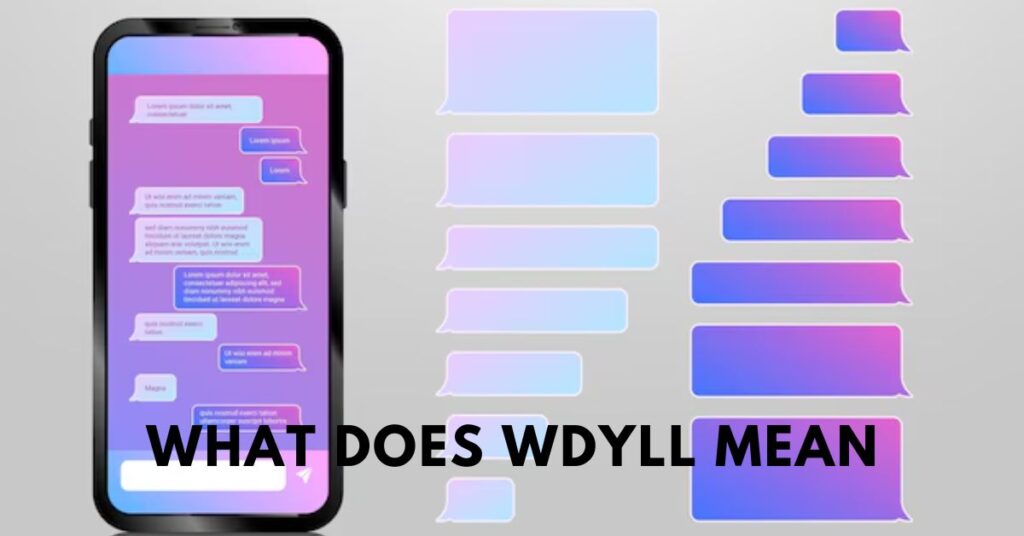In today’s fast-paced digital world, communication has evolved into a unique blend of brevity and creativity. As we navigate our way through countless texts, tweets, and social media posts, we often encounter a flurry of acronyms that can leave us scratching our heads. Among these short forms is WDYLL—a modern acronym that has sparked curiosity among many. What does WDYLL mean? Whether you’ve stumbled upon it in conversations or seen it pop up on your favorite platforms, understanding its significance is key to staying connected with the latest trends in online language. Let’s dive deeper into this intriguing acronym and uncover what lies beneath its letters!
What is an acronym?
An acronym is a type of abbreviation formed from the initial letters of a phrase. These condensed forms serve to simplify communication, making lengthy expressions easier to remember and use.
Acronyms are prevalent in various fields, from technology to healthcare. For instance, “NASA” stands for the National Aeronautics and Space Administration, efficiently conveying an organization’s purpose through just four letters.
In everyday conversations, acronyms often pop up in casual chats or text messages. They provide a quick way to express ideas without getting bogged down by unnecessary words.
While some acronyms become universally recognized over time—think “LOL” for laughing out loud—others remain niche or context-specific. Their meanings can vary widely based on where they’re used and who’s using them. This versatility adds layers of richness to language as it evolves in our digital age.
The history and evolution of acronyms
Acronyms have a fascinating history that stretches back centuries. They emerged as shorthand to simplify communication, especially in contexts like military and medical fields.
In ancient times, people used abbreviations for lengthy names or terms. The Romans famously employed “SPQR” (Senatus Populusque Romanus) to represent their government.
Fast forward to the 20th century: acronyms exploded during World War II with phrases like RADAR (Radio Detection and Ranging). This trend continued into the digital age.
The rise of texting and social media has transformed how we use acronyms today. Terms once limited to specific industries infiltrated everyday language, making communication quicker than ever before.
Now, new acronyms pop up regularly as cultural trends shift. Language evolves rapidly in our fast-paced world, illustrating just how dynamic human interaction can be.
WDYLL: An introduction to the modern acronym
WDYLL is one of the latest acronyms to gain traction in our digital conversations. It stands for “What Do You Love Life?” This phrase captures a sense of curiosity and invites deeper discussions about personal passions and experiences.
Acronyms like WDYLL thrive in today’s fast-paced communication landscape. They allow people to express complex thoughts succinctly, making interactions feel more dynamic and engaging.
With social media as its playground, WDYLL often pops up among friends or followers seeking to share their interests or check in on what others find meaningful. Its casual nature resonates with younger audiences who appreciate brevity.
As language evolves with technology, acronyms reflect cultural shifts. WDYLL serves not just as a question but also as an invitation—a prompt that encourages connection over superficial exchanges.
Common usage of WDYLL in social media and texting
WDYLL has quickly become a staple in the lexicon of social media and texting. It’s often used among friends to spark engaging conversations or gauge interest in plans.
On platforms like Instagram and Twitter, you’ll see it pop up in posts about spontaneous outings. For example, someone might share an exciting photo and add WDYLL? This invites others to join in on the fun.
In group chats, WDYLL serves as a casual way to check what everyone is up to. It’s simple yet effective for coordinating hangouts without lengthy messages.
The beauty of acronyms like WDYLL lies in their ability to convey meaning swiftly. In fast-paced digital communication, this shorthand keeps interactions lively and engaging while saving time.
Decoding WDYLL: Different interpretations and meanings
WDYLL can stand for different phrases, depending on the context and conversation. The most common interpretation is “What Do You Look Like?” This usage often pops up in social media discussions where users share photos or describe their appearances.
Another less frequent meaning could be “What Do You Love Life?” This variation captures a more philosophical approach, inviting deeper conversations about interests and passions.
In some contexts, it might even represent “Why Don’t You Live Life,” emphasizing a carefree attitude towards living fully in the moment.
These interpretations showcase how acronyms can shift based on tone and intent. Understanding these nuances enhances communication, making interactions richer and more meaningful.
The impact of acronyms on communication and language
Acronyms have revolutionized the way we communicate. They save time and space, especially in our fast-paced digital world. Instead of typing out lengthy phrases, a simple acronym can convey complex ideas quickly.
These shorthand expressions often create a sense of belonging among users. When people share acronyms like WDYLL, they connect over shared understanding and experiences.
However, the rise of acronyms also brings challenges. Misinterpretation can lead to confusion or miscommunication. Not everyone may be familiar with specific terms or phrases used within certain groups.
Acronyms reflect cultural shifts too. As language evolves, new ones emerge while others fade away. This dynamic nature keeps communication fresh but requires adaptability from all speakers involved.
In essence, acronyms are more than mere shortcuts; they’re integral to modern language evolution and interaction styles.
Conclusion: How to use WDYLL appropriately in conversation
Using WDYLL in conversation can be both fun and effective when done correctly. It’s important to know your audience. If you’re chatting with friends who are familiar with internet slang, dropping WDYLL into the mix is perfectly acceptable.
However, in more formal settings or among those who may not be up-to-date with modern acronyms, it’s best to avoid jargon that might cause confusion. Context matters—consider whether everyone will understand what you’re communicating.
Additionally, using WDYLL can serve as a great icebreaker or prompt deeper discussions about feelings and experiences. Just remember that while acronyms add flair to communication, clarity should always come first. Keep your conversations engaging by mixing in some casual language but ensure everyone is on the same page regarding its meaning.
FAQs
1. What is “What Does WDYLL Mean”?
WDYLL is an acronym that stands for “What Do You Love Life?” It is used in digital communication to spark conversations about personal interests, passions, and experiences. The acronym invites deeper discussions and adds a personal touch to online interactions.
2. How did WDYLL originate?
The origin of WDYLL is not well-documented, but it emerged as part of the broader trend of creating acronyms for quick and engaging digital communication. As social media and texting cultures evolved, users sought concise ways to express curiosity and initiate meaningful conversations, leading to the creation of acronyms like WDYLL.
3. Can WDYLL have different meanings?
Yes, WDYLL can have multiple interpretations depending on the context. Besides “What Do You Love Life?” it may also stand for “What Do You Look Like?” or “Why Don’t You Live Life?” These variations reflect different conversational tones and purposes, from casual inquiries about appearance to philosophical prompts about living fully.
4. In what contexts is WDYLL most commonly used?
WDYLL is primarily used in informal digital communication, such as social media posts, text messages, and group chats. It is often seen in casual settings where users share updates or invite others to discuss their interests and experiences. The acronym is particularly popular among younger audiences familiar with internet slang.
5. What are some tips for using WDYLL effectively?
When using WDYLL, consider your audience and the context of the conversation. It works best in informal settings with friends or acquaintances who understand internet acronyms. Ensure that the use of WDYLL aligns with the tone of the conversation and serves to enhance engagement rather than create confusion.







